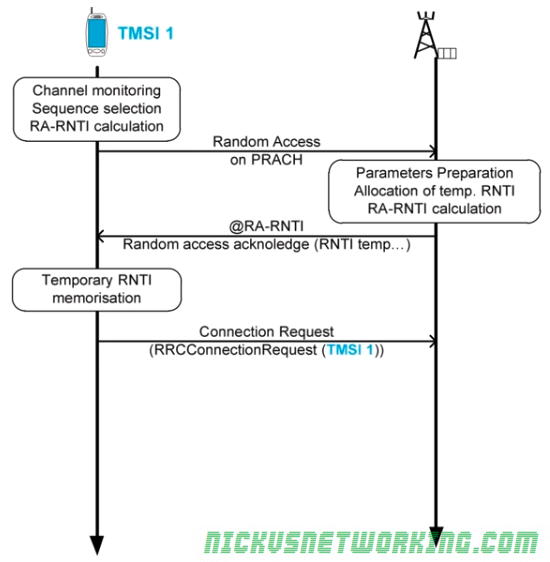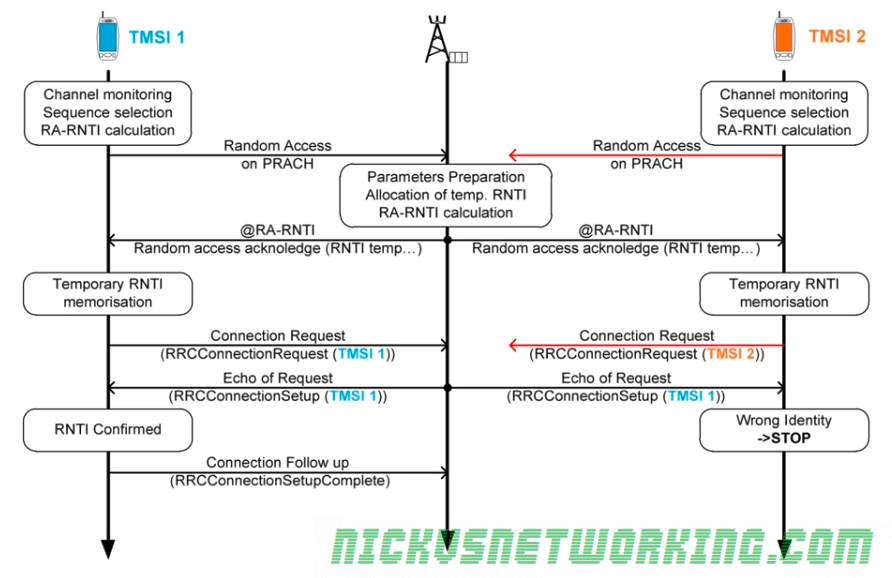These are my lecture notes from IMT’s NET02x (4G Network Essentials) course, I thought I’d post them here as they may be useful to someone. You can find my complete notes here.
LTE mostly relies on reservation based protocols, meaning resources are broken up into smaller elements which are reserved and allocated dynamically as needed.
The problem is when it comes time to add a new UE to an eNB, the UE needs to be allocated a resources to be allocated a RNTI so it can request / be allocated resources.
In the uplink a group of resources is reserved so any new UE can indicate it’s presence and be assigned an RNTI, so it can go on to request & be allocated resources.
This is done on the Physical Random Access Channel (PRACH), made up of 6 resource blocks, and occurs every 1-20ms depending on what the operator has configured.
Access to the PRACH is by CDMA (Code Division Multiple Access). Without going into the mechanics of CDMA the important thing to note is that on CDMA two transmissions can occur at the same time and as long as they are each using a different one of CDMA’s 64 Codes the eNB will be able to distinguish between the two transmissions.
When attempting to associate the UE will send a CDMA symbol with one of the 64 CDMA sequence codes across all 6 resource blocks. As we discussed the eNB will still be able to determine the code used even if multiple UEs were transmitting at the same time each hoping to associate with the eNB.

UE Attach and RNTI Assignment
The UE begins by listening to the eNB to identify when the Physical Random Access Channel (PRACH)is scheduled.
Once the UE knows when the PRACH is going to be it transmits one of the 64 possible CDMA codes on the PRACH in all 6 of the resource blocks in the Random Access Channel.
The eNB detects the transmission and which one of the 64 CDMA codes was used by the UE wishing to attach, and the eNB assigns it an RNTI.
At this point only the eNB knows the RNTI, it needs to let the UE know it’s assigned RNTI so it can start scheduling.
The eNB creates a new identifier RA-RNTI or Random Access – RNTI. This is calculated using the CDMA code used by the UE in it’s transmission on the PRACH and the RNTI to be assigned.
The eNB then allocates a resource for that RNTI so the UE can send a response back in the form of a Connection Request containing the TMSI.

The eNB then echos back the connection request on the channel allocated to the RNTI.
The echo procedure means if two UEs happened to use the same CDMA Code and both believed they were the owner of the RNTI assigned by the eNB, the eNB would either have received only one of the responses, in which case the other would detect the wrong identity in the echo and start the random access procedure again, or both would be lost and both would start the random access procedure again, as shown below:

As we can see the eNB recieved TMSI1’s Connection Request, and sent back the echo, TMSI one confirmed it and continued the setup procedure, while TMSI2’s Connection Request was not received by the eNB and it knows this beacuse the echo did not contain it’s TMSI. TMSI2 detects thew wrong identity and stops that process and starts the random access procedure again.
One thought on “IMTx: NET02x (4G Network Essentials) – Radio Interface – 6. Random Access”